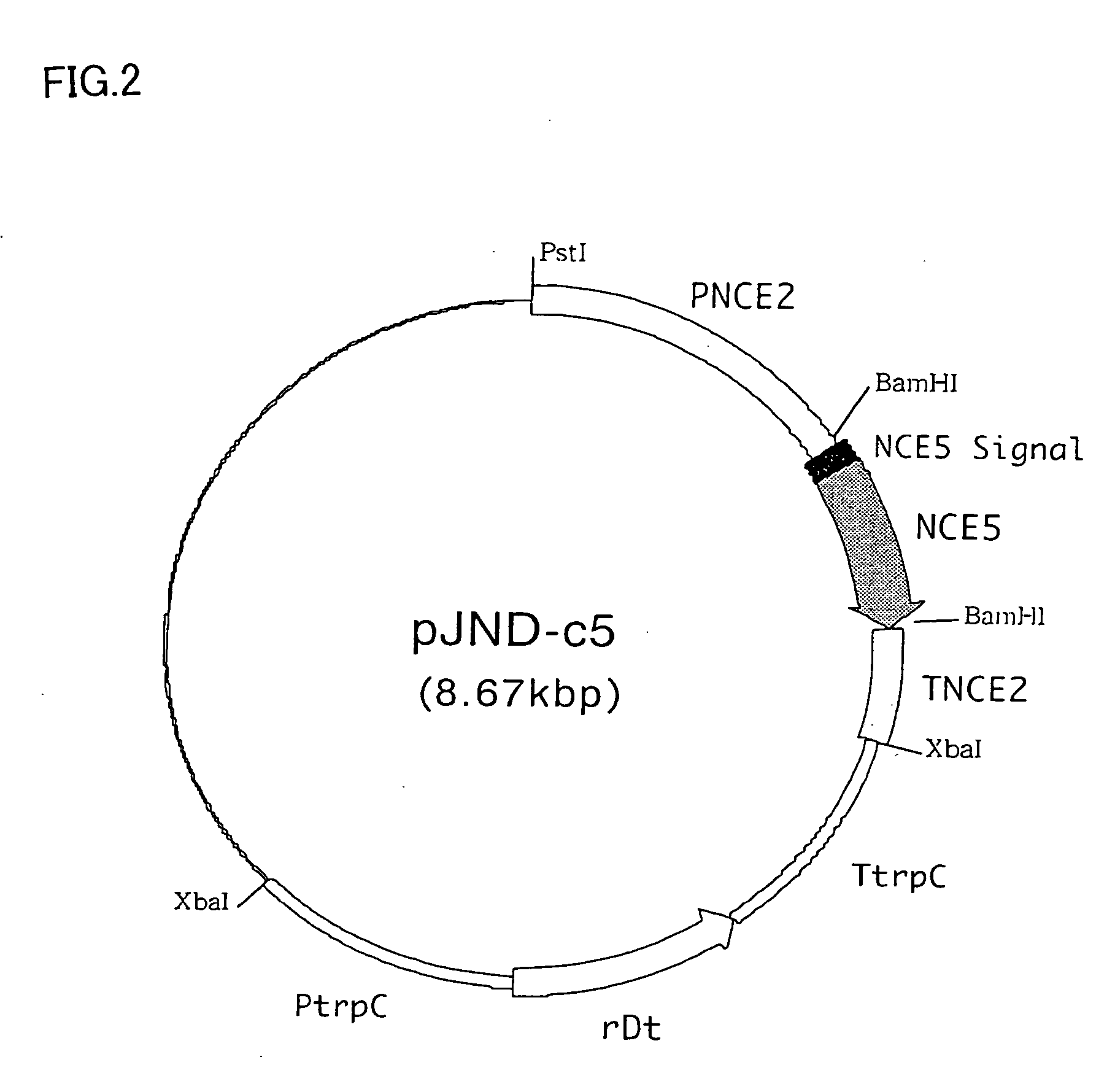Endoglucanase nce5 and cellulase preparations containing the same
a technology of endoglucanase and cellulase, which is applied in the direction of pulp properties modification, enzymology, fat/resin/pitch/waxe removal in pulp, etc., can solve the problems of affecting the practical use of cellulose-containing fabrics, requiring a cost of adding chemical products, and improving the preparation of cellulase products, etc., to achieve efficient and inexpensive treatment of cellulose-containing fabrics
- Summary
- Abstract
- Description
- Claims
- Application Information
AI Technical Summary
Benefits of technology
Problems solved by technology
Method used
Image
Examples
example 1
Isolation and Purification of a Component Having Absorbent Cotton Fibril-Releasing Activity from Humicola insolens
[0051]Humicola insolens MN200-1 (FERM BP-5977) was inoculated into an (N) medium (5.0% Avicel, 2.0% yeast extract, 0.1% peptone, 0.03% calcium chloride, 0.03% magnesium chloride, pH 6.8) and cultured at 37° C. on a shaker. After 7 days of the culturing, the thus obtained culture broth was centrifuged at 7,000 rpm for 20 minutes to remove the cells, and the resulting culture filtrate was used as a crude cellulase preparation solution.
[0052] A 200 ml portion of this crude cellulase preparation solution was adjusted to a solution of 1 M in final concentration ammonium sulfate and then applied at a flow rate of 20 ml / min to a Source PHE column (gel volume 150 ml, mfd. by Amersham Pharmacia Biotech) which had been equilibrated in advance with 1 M ammonium sulfate solution. Next, this was eluted and fractionated by a linear gradient elution of from 1.0 M to 0 M ammonium sulf...
example 2
Partial Amino Acid Sequence of Cellulase NCE5
(1) Identification of N-Terminal Amino Acid Sequence
[0061] In order to determine N-terminal amino acid sequence of the protein purified in Example 1, the NCE5 fraction was treated with SDS-PAGE mini (mfd. by Tefco), transferred on a PVDF membrane by electroblotting, stained with Coomassie Brilliant Blue R250 (mfd. by Nakalai Tesque), decolorized, washed with water and then air-dried. When the portion where a 25 kDa protein was blotted was cut out therefrom and applied to a protein sequencer Model 492 (mfd. by PE Applied Biosystems) in an attempt to analyze the N-terminal amino acid sequence, a signal by Edman degradation was not obtained, so that it was revealed that the N-terminal amino acid was modified and protected. Accordingly, the membrane was soaked in 0.5% polyvinylpyrrolidone (molecular weight 40,000, mfd. by Sigma) / 100 mM acetic acid solution at 37° C. for 30 minutes to effect blocking of protein unbinding moiety on the membr...
example 3
Cloning of Cellulase NCE5 cDNA
(1) Isolation of cDNA and Preparation of Library
[0067] For the screening of the gene of a cellulase component NCE5, mRNA was prepared from Humicola insolens MN200-1 and a library was prepared by synthesizing cDNA using a reverse transcriptase.
(i) Preparation of Total RNA
[0068]Humicola insolens MN200-1 was cultured in a cellulase inducing medium, preferably the (N) medium described in Example 1, for 2 days and the resulting cells were recovered by centrifugation (3,500 rpm, 10 minutes). A 3 g portion of the cells were washed with sterile water, frozen with liquid nitrogen and then pulverized using a mortar and a pestle in liquid nitrogen. Total RNA was isolated from the thus pulverized cells using ISOGEN (mfd. by Nippon Gene) in accordance with the manual attached thereto, and the total RNA was confirmed as a stained image by a formaldehyde agarose gel electrophoresis.
(ii) Preparation of poly(A) Tail+RNA (=mRNA)
[0069] A 1 mg portion of the total...
PUM
| Property | Measurement | Unit |
|---|---|---|
| Length | aaaaa | aaaaa |
| Length | aaaaa | aaaaa |
| Temperature | aaaaa | aaaaa |
Abstract
Description
Claims
Application Information
 Login to View More
Login to View More - R&D
- Intellectual Property
- Life Sciences
- Materials
- Tech Scout
- Unparalleled Data Quality
- Higher Quality Content
- 60% Fewer Hallucinations
Browse by: Latest US Patents, China's latest patents, Technical Efficacy Thesaurus, Application Domain, Technology Topic, Popular Technical Reports.
© 2025 PatSnap. All rights reserved.Legal|Privacy policy|Modern Slavery Act Transparency Statement|Sitemap|About US| Contact US: help@patsnap.com


